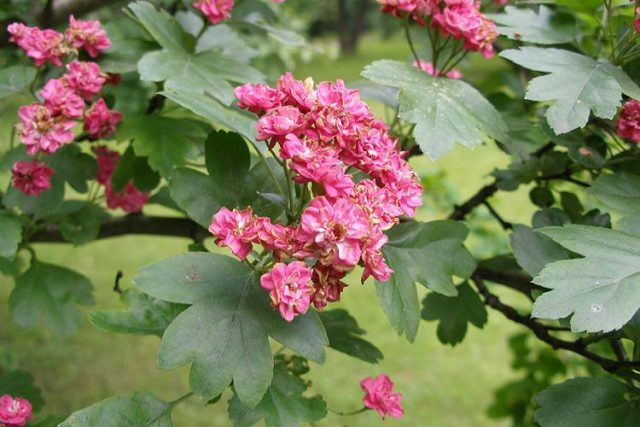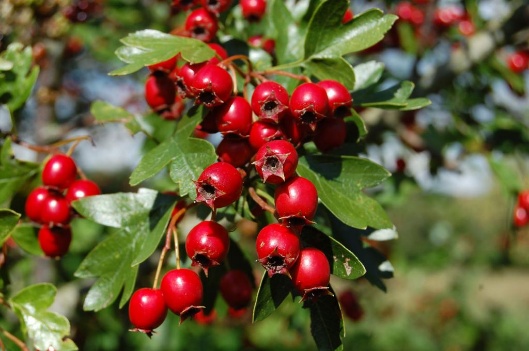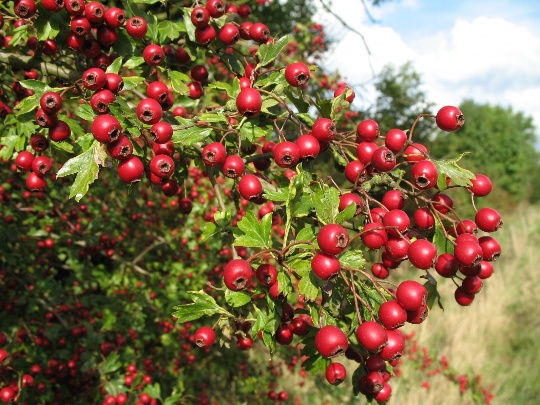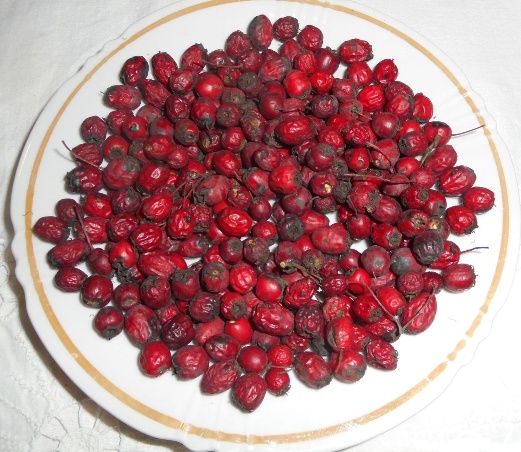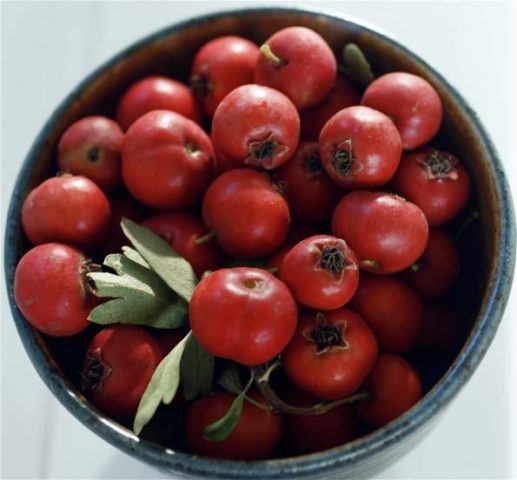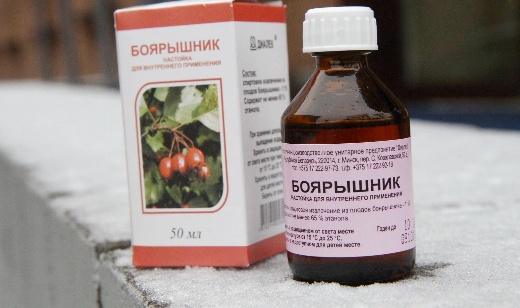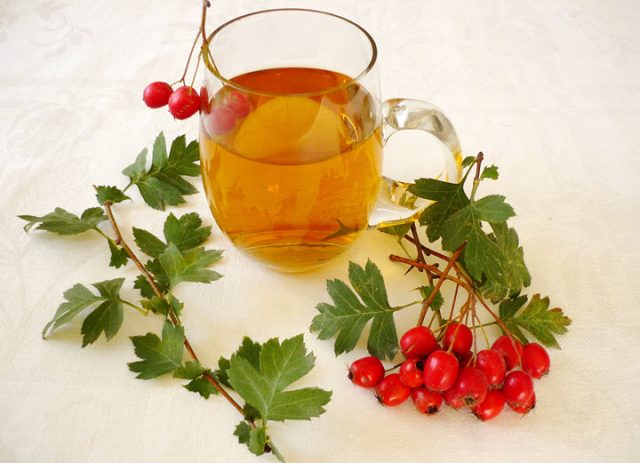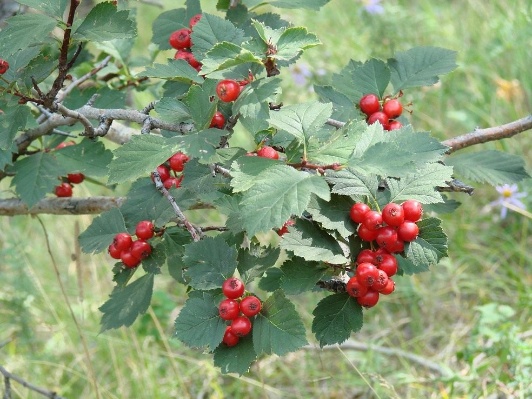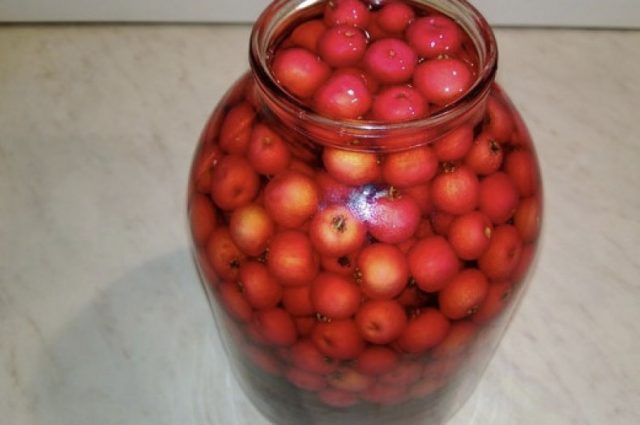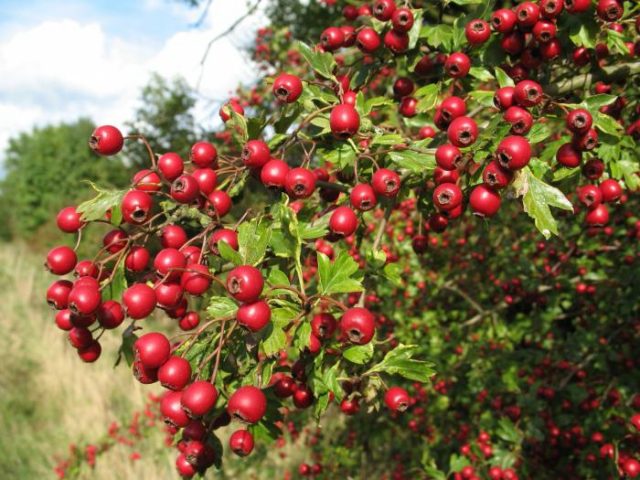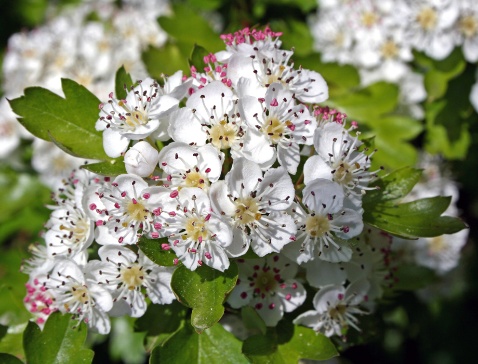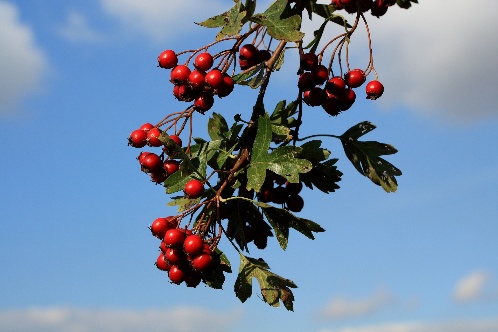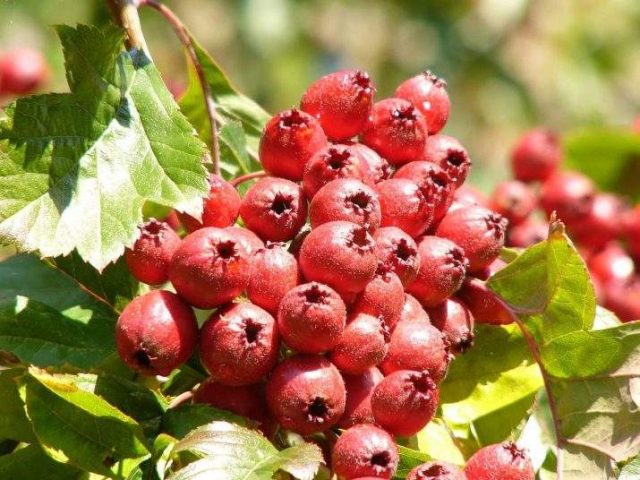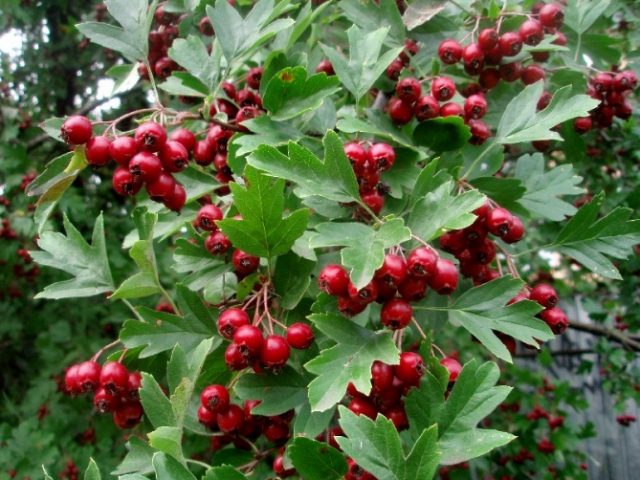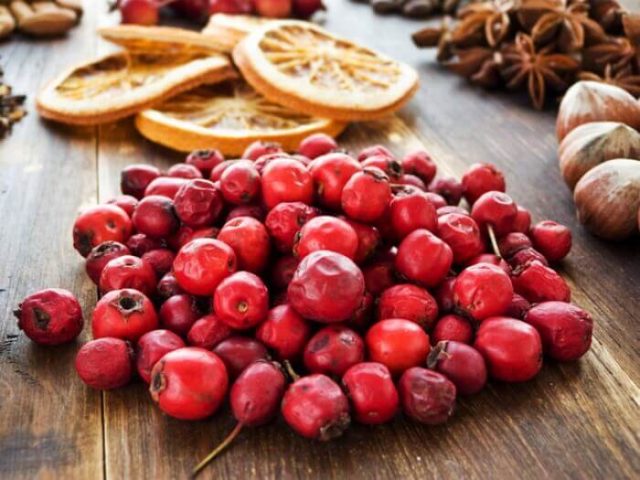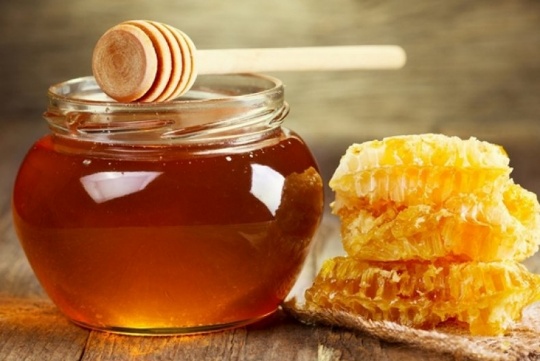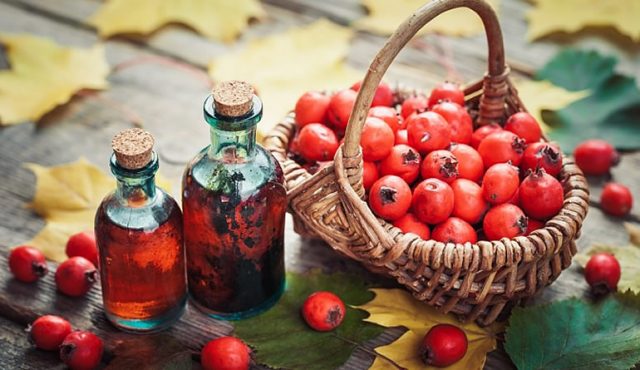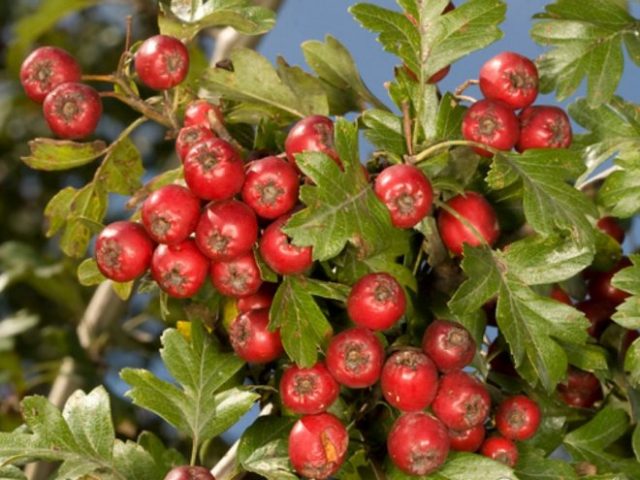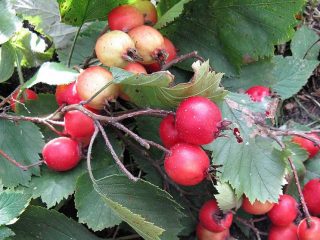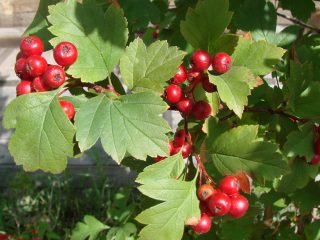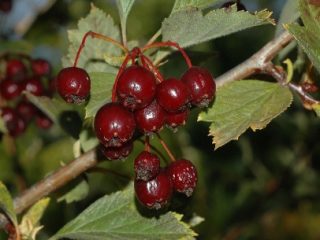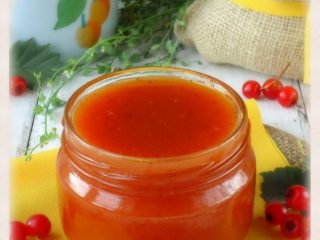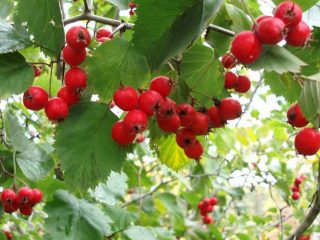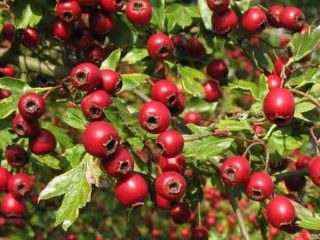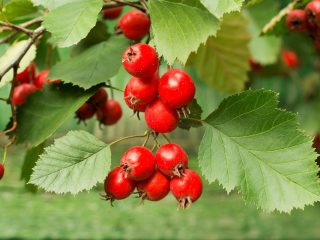Content
- 1 Which hawthorn is considered medicinal?
- 2 Medicinal properties and contraindications of hawthorn
- 3 What are the benefits of hawthorn berries for the human body?
- 4 What does hawthorn help with?
- 4.1 Benefits of hawthorn for the heart
- 4.2 For vascular atherosclerosis
- 4.3 After a stroke
- 4.4 For hypertension
- 4.5 For cholesterol
- 4.6 For diabetes
- 4.7 For pancreatitis
- 4.8 Benefits for the liver
- 4.9 For cholelithiasis
- 4.10 For gastritis with high acidity
- 4.11 For oncology
- 4.12 For colds
- 4.13 For kidney diseases
- 4.14 During menopause
- 5 What are the benefits of hawthorn: effects on the body
- 6 Uses of hawthorn
- 7 How is hawthorn used in cosmetology?
- 8 Hawthorn honey: beneficial properties and contraindications
- 9 Contraindications to taking hawthorn
- 10 Conclusion
Hawthorn, whose beneficial properties and contraindications are confirmed by official medicine, has been known as a medicinal plant since the 16th century. Its beneficial properties were appreciated, but were used only for stomach problems: dysentery and diarrhea. With the development of medicine, when it became possible to diagnose many internal diseases, it turned out that this shrub is beneficial for many other problems.
Which hawthorn is considered medicinal?
In nature, there are 380 “wild” species of hawthorn. Nobody considered the different forms and hybrids at all. But only some types of hawthorn have medicinal properties:
- Daurian (Crataegus dahurica);
- green-fruited (Crataegus chlorocarpa);
- monopistillate (Crataegus monogyna);
- common/spiny (Crataegus laevigata);
- pentafestal (Crataeguspentagyna);
- blood red (Crataegussanguinea);
- some other types.
These are the most common varieties used in medicine. The whole shrub has beneficial properties: roots, leaves, flowers and fruits.
In fact, this is not a pome crop, but a stone fruit crop.
There are few vitamins in fruits. Hawthorn berries have beneficial properties for the human body due to other substances:
- flavonoids:
- quercitrin;
- hyperoside;
- acetylvitexin;
- quercetin;
- vitexin;
- hydroxycinnamic acids:
- chlorogenic;
- coffee.
Treatment with hawthorn is only possible if it is used as an auxiliary and not as a primary remedy.
Medicinal properties and contraindications of hawthorn
The most common, accessible and numerous type of medicinal plant: red hawthorn.When they talk about the beneficial properties of these plants, they most often mean the medicinal properties and contraindications of red hawthorn.
Therefore, when taking preparations of this plant, you must also take into account the type of shrub or tree. In many ways, the beneficial properties of drugs depend on the chemical composition of the starting materials. Since the plants are unpretentious and can grow in different soils, the chemical composition will vary. The chemical compositions of different species of this genus also differ from each other. Therefore, we can only talk about a certain average value, which cannot be taken as a guide to action when independently collecting raw materials from wild bushes.
Composition of hawthorn
The beneficial properties and use of hawthorn in modern medicine are explained by the high content of potassium in the berries, which has a beneficial effect on the cardiovascular system. But besides potassium, B. prickly contains a lot of other macro- and microelements. 100 g of raw material contains:
- 1310 mg potassium;
- 300 mg calcium;
- 100 mg manganese;
- 4 mg each of iron and magnesium;
- 1180 mcg selenium;
- 200 mcg boron;
- 37 mcg cobalt;
- 29 mcg copper;
- 10 µg nickel;
- 7 mcg zinc;
- 6 mcg each of strontium and iodine;
- 5 µg lead;
- 1 mcg chromium.
Hawthorn fruits have also been used for osteoporosis. It is impossible to cure this disease. Its development is only suspended. A large amount of calcium in berries delays the development of the disease.
In addition to various elements, berries also contain other substances:
- tanning;
- essential oils;
- organic acids:
- oleic;
- coffee shop;
- lemon;
- tartar;
- phytosterols;
- carotenoids;
- glycosides;
- pectins.
Due to this composition, the fruits may not benefit everyone.The vitamin composition of hawthorn can bring both benefits and harm to health.
Content of vitamins in hawthorn
The amount of vitamins in leaves and flowers is usually not checked, and we are always talking about fruits. The vitamin composition of berries is poor. 100 g of fruits contain:
- 2 mg vitamin E;
- 60 mg vitamin C;
- 16 mg vitamin A.
In winter, these are the most important vitamins for the human body, but hawthorn fruits are more useful due to the above mineral composition.
The absolute values of the numbers are not very informative. If we calculate as a percentage of the daily requirement for vitamins for the human body, the picture will not be so rosy:
- vitamin A – 259%;
- vitamin C – 100%;
- vitamin E – 13.3%.
Vitamin A has a cumulative effect. It accumulates in the liver, gradually destroying the organ. An overdose of vitamin C for a long period of time if you stop using it will lead to hypovitaminosis C. And only vitamin E can withstand the dose, taking into account the fact that it is also found in other products.
Calorie content of fresh hawthorn
The main component of fresh fruits, like any other fruit, is water. Its share in 100 g of product is 82.4 g. Protein 0.8 g, carbohydrates 14 g, fat 0 g, fiber 1.6 g. Nutritional value of 100 g is only 58.5 kcal. But using fruits for weight loss is not recommended. The berries have the beneficial property of lowering blood pressure, which is undesirable in this situation, and the harmful property of poisoning the body when consumed in large doses.
Healing properties of hawthorn
In official medicine, preparations from hawthorn are intended to treat the heart and blood vessels. They increase the contraction of the heart muscle, but reduce its excitability.Thanks to triterpene acids, tincture and extracts from the bush improve blood circulation and eliminate pain in the heart area. Hawthorn berries are beneficial for the body and for other diseases:
- hypertension;
- headaches;
- allergies;
- diabetes mellitus;
- disorders of the thyroid gland;
- epilepsy.
Help restore normal functioning of the body during menopause. Although, with a strict approach, menopause cannot be considered a disease, this does not make it any easier for women.
What are the benefits of hawthorn berries for the human body?
Due to the beneficial property of affecting blood vessels, berries are useful not only for diseases. When blood circulation improves, the body's condition automatically normalizes. In this regard, the fruits are useful for men and women in other areas.
Hawthorn: beneficial properties and contraindications for men
Hawthorn is not able to solve men’s problems “on its own.” It is prescribed as an auxiliary component to the list of other medications. Only in the very early stages of erection, when the problem is related to poor blood supply to the organs, the hawthorn preparation can help without other medications.
Very often, impotence occurs against the background of psychological stress. By calming the nervous system, the medicine restores potency. Erection problems also occur when blood stagnates in the groin area. By improving blood supply, medicines from hawthorn eliminate this stagnation.
Hawthorn: beneficial properties and contraindications for women
The main benefit for women here is calming the nervous system. If valerian requires long-term use before it works, and motherwort puts you to sleep, then hawthorn quickly calms the nervous system.For pain during menstruation, it is also a good pain reliever.
Is it possible to take hawthorn during pregnancy?
The main contraindication during pregnancy: self-prescribing the drug. Before use, you should consult your doctor. If the doctor has approved, the medicine will normalize the functioning of the gastrointestinal tract, eliminate nervousness, boost immunity and bring the heart rate back to normal.
Is it possible to take hawthorn while breastfeeding?
A healthy body does not need any extraneous therapeutic adjustments. Using medications too early leads to improper formation of body reactions. The baby's intestines are underdeveloped and lack the necessary bacteria. Getting into the child's body through mother's milk, hawthorn will cause harm instead of benefit. It will prevent the formation of normal microflora and lead to problems with the gastrointestinal tract. Before using this folk remedy, you should consult your doctor.
Contraindications to taking hawthorn for women
Considering the original use of this plant back in the Middle Ages, it is better not to use it in the last stages of pregnancy. There is no need for constipation at this time. It is also undesirable to use drugs during menstruation for women who already have very heavy bleeding. Hawthorn improves blood circulation not only in the brain.
Is hawthorn okay for children?
Like any medicine, hawthorn should not be used “for prevention”. You can’t follow the principle “it’s just grass, what can happen.” A lot can happen. The average child does not yet have pathologies in their bodies that require intervention. If the child has serious illnesses, the doctor will prescribe the medicine.
The benefits of hawthorn for the elderly
Preparations from this shrub are used for so many diseases that they begin to seem like a panacea for all ills. In fact, the beneficial properties of this plant revolve around the functioning of the cardiovascular system and gastrointestinal tract. Moreover, in the latter case, the indications for use are very narrow - diarrhea. Stomach ulcers cannot be cured with hawthorn.
But it will work out:
- normalize heart function;
- improve cerebral circulation;
- reduce blood pressure;
- remove heart rhythm disturbances;
- get rid of headaches.
Constipation is common in older people. When consuming hawthorn, care must be taken to ensure that the normalization of the cardiovascular system does not interfere with constipation. Otherwise, instead of benefit, a person will receive an additional problem.
What does hawthorn help with?
“In splendid isolation,” these medications help according to the medieval principle “either he gets well, or everything is in the hands of God.” It will be better if the drug is prescribed by a doctor as an adjuvant in combination with other medications. But hawthorn tinctures and extracts are prescribed for many diseases. Since this berry grows freely in nature, you can use useful recipes and make your own preparations from hawthorn.
Benefits of hawthorn for the heart
This is the main use of B. vulgare in modern official medicine. Preparations for the treatment of the cardiovascular system are obtained from the common hawthorn (prickly). Berries and flowers that have just begun to bloom are used to make medicine.
Drugs are prescribed for almost all diseases associated with CVS:
- myasthenia gravis;
- atrial fibrillation;
- angioneurosis;
- paroxysmal tachycardia;
- angina pectoris;
- hyperthyroidism with tachycardia;
These same drugs are a good way to combat insomnia caused by nervous excitement. But they must be used as prescribed by a doctor.
For vascular atherosclerosis
You cannot count on curing atherosclerosis solely with the help of hawthorn. Preparations from this plant cannot remove cholesterol plaques from the walls of blood vessels. For atherosclerosis of blood vessels, hawthorn is used for other purposes:
- decreased blood pressure;
- improved sleep;
- stimulation of the heart muscle;
- reduction of dizziness due to insufficient blood supply to the brain;
- improved blood circulation;
- reduction of shortness of breath.
For atherosclerosis, constant use of hawthorn preparations is indicated. But the pharmaceutical preparation is an alcohol tincture. Regular use of alcoholic drugs leads to alcoholism, no matter how funny it may seem. The tincture should be alternated with decoctions. There is also a delicious recipe for winter consumption: 800 g of granulated sugar is thoroughly mixed with 20 g of citric acid, then ground with 1 kg of fresh large-fruited hawthorn berries. The resulting mass is transferred to jars and sprinkled with sugar on top. Place a circle of paper soaked in alcohol on top of the sugar. The jars are covered with lids and stored in the refrigerator.
The drug without alcohol is ready. Can be consumed daily instead of jam, but no more than 150 g and no longer than 21 days. Then they take a break.
After a stroke
Hawthorn can't help much after a stroke. Medications from this plant are used to prevent strokes. This happens due to the same improvement in the blood supply to the blood vessels in the brain.
For hypertension
For hypertension, hawthorn plays its main role as a medicinal plant.It is able to reduce blood pressure. This is the case when it can be prescribed as a primary rather than an auxiliary remedy. But only at the initial stage. It must be taken under the supervision of a doctor.
For cholesterol
Don't deceive yourself. Hawthorn does not help against cholesterol. Cold, hunger and movement help here, when the body uses every drop of the nutrients it receives. He simply has nothing to put aside “in reserve.” Neither in the subcutaneous fat layer, nor on the walls of blood vessels. But preparations from this plant can improve blood flow through vessels clogged with cholesterol plaques.
For diabetes
For type 2 diabetes mellitus, hawthorn is most often consumed as berries:
- fresh;
- frozen;
- dried.
The flowers and leaves of the plant are also used. Taking berries alone can be alternated with decoctions and infusions. The action of hawthorn is limited by its beneficial properties. It can improve blood circulation and relieve painful spasms. Improves skin condition. Helps fight painful fatigue. But it is not able to replace specialized drugs.
Otherwise, instead of the expected benefit, the person will receive harm in the form of severe colic.
Such a useful property of the bush as the ability to stop diarrhea can play a cruel joke. In diabetics, bowel dysfunction often manifests itself in the form of constipation. Taking medications for this disease requires stricter medical supervision than any other.
For pancreatitis
Pancreatitis is inflammation of the pancreas. All parts of the plant have anti-inflammatory properties to a more or less pronounced degree.It is best to use hawthorn root for pancreatitis. This part has the most powerful anti-inflammatory effect: 100 g of root is poured into liters of water and boiled for 10 minutes. Cool and filter. Take 1 tbsp. l 3 times a day.
Benefits for the liver
For the liver, hawthorn is more harmful than beneficial. Like any medicine, the plant is poisonous in large doses. And all toxins are eliminated from the human body through the liver. But with inflammation of the gallbladder adjacent to the liver, hawthorn can relieve inflammation in the same way as with pancreatitis.
For cholelithiasis
This is the case when you don’t need to self-medicate. Hawthorn can be very dangerous for gallstone disease. The plant can increase the secretion of bile, washing away sand from the gallbladder. But if there is too large a stone in the bladder, it will get stuck in the bile duct. This will lead to a worsening of the patient's condition. Therefore, in case of cholelithiasis, taking hawthorn is possible only after undergoing an examination and under the supervision of a doctor.
For gastritis with high acidity
It is often stated that hawthorn is useful for gastritis with high or low acidity, but no one says exactly how it affects the stomach. The same medication cannot either increase or decrease acidity, depending on the patient’s needs. This means that either in this case the medicine does not work at all, or it only causes harm. The maximum benefit for gastritis is a reduction in pain.
For oncology
Even doctors have not yet figured out the mechanism of cancer. With stage IV cancer, you can already treat yourself with anything, just like eating. In folk medicine, hawthorn is used for oncology as an antioxidant.It is believed to resist tumor growth. But tumor growth is much more successfully resisted by chemotherapy and radiation. The latter resist so successfully that the tumor shrinks, and doctors are able to remove it completely.
But preparations from hawthorn can also be taken. The main thing is not to get poisoned by them.
For colds
Hawthorn is used for colds by supporters of traditional medicine. Drinking plenty of warm water is beneficial in any case for this disease, even if it is just water. But you can make a vitamin drink by taking a glass of rose hips, viburnum and hawthorn and 3 liters of water. Pour boiling water over the berries and leave for a day. The dose is for 2 days and is intended for an adult.
For kidney diseases
For kidney diseases, hawthorn is an almost insignificant medicinal plant. It has a weak diuretic effect, but not all kidney diseases show increased urination. And the very concept of “kidney disease” is too broad for anything to be applied without first visiting a doctor.
During menopause
Hot flashes during menopause are a failure in the body's thermoregulation. A woman feels a burning sensation in her upper body. The scalp and chest become red. Increased sweating and dizziness, shortness of breath, and a feeling of causeless anxiety appear. All this is the result of a hormonal imbalance, leading to stimulation of the central nervous system. The benefit of hawthorn during menopause from hot flashes is only that the medication is able to bring the central nervous system to a normal state.
What are the benefits of hawthorn: effects on the body
Although the beneficial properties of hawthorn are fully recognized by official medicine, its benefits do not extend beyond 3 of the 4 main systems of the body: the cardiovascular system, gastrointestinal tract and central nervous system. To perceive a plant as a panacea and believe that it can be beneficial, even if you use it just like that, “for prevention,” is somewhat reckless.
Hawthorn thickens or thins the blood
The ability of medicines made from this plant to lower blood pressure shows that one of the beneficial properties of hawthorn is blood thinning. If you add alcohol, the tincture can further dilate blood vessels.
Hawthorn weakens or strengthens
This beneficial property has been known since the Middle Ages, when decoctions and berries were used to stop diarrhea due to dysentery. Today, the benefits of the shrub in this regard have decreased somewhat, but its infusions and fresh fruits are still used in our time for diarrhea.
Is there a hawthorn diet?
No. And such a diet is not recommended at all, since it does more harm than good. Hawthorn is not used at all for weight loss, even taking into account its low calorie content. With its mild diuretic effect, the only case when it can be used for weight loss is edematous “fullness”. But with such “completeness”, you should not rely on the beneficial properties of plants, but go to the doctor. Serious heart problems are possible.
The benefits of hawthorn for the body's immunity
Immunity in everyday life is boosted by heavy doses of vitamins, which hawthorn cannot boast of. Therefore, its benefits in restoring immunity are questionable, but the harm with excessive consumption is undeniable. It is better to replace it with rose hips. Rosehip decoction will bring much more benefits.
Uses of hawthorn
From hawthorn they make:
- tinctures;
- decoctions;
- jam;
- raw materials (fresh berries pureed with sugar);
- liqueurs.
But self-medication with these delicacies is not advisable.
How much hawthorn can you eat per day?
There are recommendations for consuming no more than 150 g of berries per day. But even this dose can bring harm rather than benefit. In any case, eating a glass of fruit during the day at night can already cause pronounced symptoms of poisoning.
Many people take lightly the medicinal plants recognized by official medicine, believing that since they are not “chemistry”, they cannot do any harm. At the same time, forgetting that drinking 1-2 drops of digitalis tincture normalizes heart function, and a whole bottle is fatal. Hawthorn is weaker, but can also cause serious harm.
The use of hawthorn fruits in folk medicine
In folk medicine, berries are used even where they should not be used at all. In particular, as a prevention of gastrointestinal diseases in children. Meanwhile, regular use of medications weakens the body and, on the contrary, leads to the appearance of diseases. The video just shows the belief of a fan of traditional medicine that the berries should be taken both when the heartbeat is rapid and when it slows down. But that doesn't happen.
How is hawthorn used in cosmetology?
The only area where the beneficial properties of the plant can be used without the supervision of a doctor. Hawthorn is used in the form of masks made from berries and decoctions. Relieves irritation, removes red spots and disinfects the skin. There is much more benefit from the plant than harm.
Hawthorn honey: beneficial properties and contraindications
The plant is a poor honey plant. Also, bees receive little pollen from it. Finding pure hawthorn honey is technically impossible.The guaranteed beneficial properties of hawthorn honey are the same as those of any other natural variety of this product: the main thing is that it is a natural antibiotic. Everything else is very selective and in too small doses to really benefit the human body.
Contraindications are the same as for other types of honey:
- allergy to bee products;
- some stages of diabetes;
- emphysema;
- bronchial asthma;
- heart failure;
- respiratory tract hemorrhages;
- myocarditis;
- other contraindications.
The miraculous power of honey is often greatly exaggerated.
Contraindications to taking hawthorn
The situation is the same as with all medications: there are no poisons and no drugs, there is a dose. So it is here. Using the shrub for treatment can be beneficial if used wisely and in the right doses. And it can be harmful if you overdo it.
In small doses, hawthorn remedies can regulate tachycardia, but in large doses they will cause it. Instead of benefit, this plant causes harm in some diseases of the stomach and gallbladder. It is not suitable for people suffering from constipation.
The herbal component in dietary supplements is often an overdose that causes poisoning. Traditional recipes: 1 tbsp. l. per glass of boiling water - they also offer poison. The norm would be 1 teaspoon. And in all cases, taking the drug should not last more than 21 days.
Eating fresh berries in excessive doses causes food poisoning and severe pain in the gastrointestinal tract. In order for hawthorn to bring benefit instead of harm, it should not be prescribed to oneself. It should be used only on the recommendation of a doctor and under his supervision.
How does an allergy to hawthorn manifest?
You may also be allergic to this plant. Its symptoms:
- itching on the lips and in the mouth;
- swelling;
- nausea;
- diarrhea (the main problem that hawthorn should eliminate);
- colic;
- “unreasonable” runny nose or cough.
And here it is necessary to urgently remove the patient from this drug, and not rely on traditional medicine.
Conclusion
Hawthorn, whose beneficial properties and contraindications are as extensive as any “chemical” medicine, remains an important auxiliary component in the treatment of cardiovascular disease. If you do not abuse these herbal medicines, they will only bring benefits. But it is important to know when to stop.
